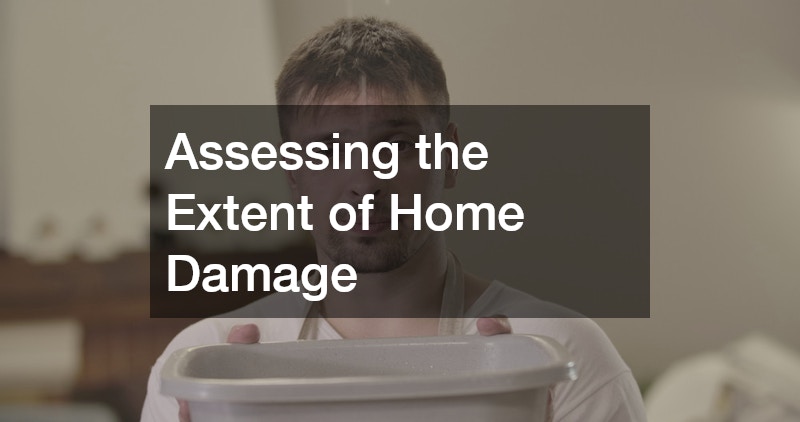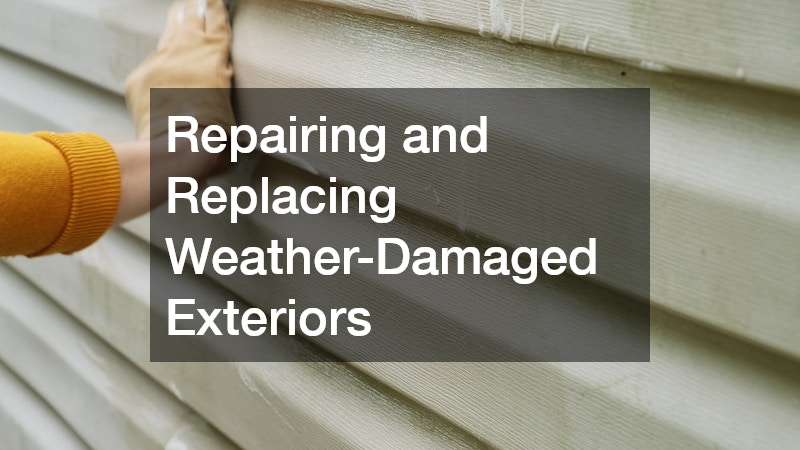When water damage strikes, it often arrives unexpectedly and disrupts the comfort, safety, and structure of a home. Whether caused by a burst pipe, heavy rainfall, or a slow, unnoticed leak, water can quickly infiltrate walls, floors, and ceilings, leaving behind extensive damage that requires immediate attention. The aftermath can feel overwhelming—furniture, flooring, and sentimental items can be lost, and the uncertainty about what comes next can heighten stress. Yet, taking the right steps after the damage occurs can make all the difference in how successfully a homeowner recovers.
Beyond the immediate cleanup, dealing with water damage involves a deeper understanding of a home’s systems—its plumbing, roofing, and foundation all work together to protect the structure from further harm. Addressing these interconnected parts ensures not only that the home can be repaired efficiently but also that future problems can be minimized. Rebuilding after water damage is more than a restoration process; it’s a chance to strengthen the home’s resilience, enhance its functionality, and safeguard it from recurring issues.
Assessing the Extent of Home Damage

The first step after any water-related incident is assessing how far the damage has spread. Even a small amount of standing water can lead to significant issues if it seeps into walls, subflooring, or insulation. A general assessment should include checking visible surfaces for discoloration, peeling paint, or soft spots, as well as identifying any unusual odors that may indicate moisture trapped behind walls. It’s also essential to evaluate the safety of the affected areas, ensuring that electrical systems are secure and that the structure remains stable before any repairs begin.
Homeowners should consider professional water damage restoration services to conduct a thorough inspection using advanced tools like moisture meters and infrared imaging. These professionals can pinpoint hidden dampness, determine the full extent of the problem, and develop a plan for drying and repairing the home efficiently. This process often includes removing damaged materials, sanitizing the area to prevent mold growth, and using industrial-grade equipment to ensure complete drying. Early intervention helps minimize both repair costs and long-term risks to the home’s integrity.
Eliminating Health Risks After Moisture Exposure
Water damage often leaves behind more than visible destruction—it creates the ideal environment for mold to thrive. Mold spores can spread rapidly within 24 to 48 hours of exposure to moisture, posing health risks to anyone living in the home. General cleaning or surface wiping might temporarily mask the problem, but effective removal requires addressing both the cause of the moisture and the extent of contamination. Preventing mold from reappearing means maintaining good airflow, keeping humidity levels low, and repairing any leaks or cracks promptly.
In cases where mold has already spread, professional mold remediation services become essential. These specialists isolate affected areas, remove contaminated materials, and treat surfaces with antimicrobial solutions to eliminate spores. They also identify and fix the moisture source, ensuring the environment remains dry and inhospitable to future growth. This thorough approach not only restores indoor air quality but also protects the health of everyone in the household, particularly those with allergies or respiratory sensitivities.
Protecting the Foundation From Hidden Moisture

One area of the home often overlooked after water damage is the crawl space. Because it’s typically dark and humid, it can trap moisture long after the visible damage is gone, allowing mold, pests, and structural rot to take hold. A general approach to preventing such problems includes keeping gutters clear, maintaining proper drainage around the foundation, and ensuring ventilation is adequate to discourage excess humidity. Regular inspections in this area are vital for spotting early warning signs of trouble before they escalate into costly repairs.
To provide long-term protection, many homeowners invest in crawl space encapsulation, a process that seals the area with a moisture barrier. This barrier prevents water vapor from entering the space, stabilizing humidity levels and protecting wooden structures from decay. Encapsulation also improves indoor air quality by reducing mold and dust migration into the home. Combined with a dehumidifier or sump pump, it serves as one of the most effective ways to preserve the integrity of the foundation and maintain a dry, stable environment beneath the living space.
Addressing Roof Leaks Before They Spread
Roof leaks are among the most common sources of water intrusion in homes. They can result from weather damage, missing shingles, or clogged gutters, and often go unnoticed until visible stains appear on ceilings or walls. Regular inspections are essential for catching minor issues before they escalate into significant damage. Homeowners should check for cracked flashing, worn shingles, and pooling water after heavy rainfall. Preventive maintenance can extend the lifespan of the roof and reduce the likelihood of costly repairs down the road.
When leaks are detected, consulting local roofers ensures prompt, reliable solutions tailored to the area’s specific climate conditions. These professionals can identify the root cause of the issue, perform necessary repairs, and advise on ongoing maintenance strategies. They also help ensure that repairs comply with local building codes and that all materials used are suited for long-term performance. Engaging experts who understand local weather patterns can make all the difference in protecting a home from recurring roof-related water problems.
Repairing and Replacing Weather-Damaged Exteriors

A home’s exterior plays a vital role in shielding it from the elements. Over time, constant exposure to sun, wind, and rain can wear down exterior materials, creating entry points for water. Homeowners should routinely inspect their walls for cracks, warping, or peeling paint, as these can indicate water infiltration beneath the surface. Regular maintenance—such as cleaning, sealing, and repainting—helps preserve the home’s appearance while preventing deterioration that leads to more severe structural issues.
When exterior damage is identified, updating or replacing siding can significantly enhance both protection and curb appeal. Modern siding materials are designed for durability and moisture resistance, offering a robust defense against future storms. Proper installation also ensures a tight seal that prevents water from seeping behind panels. By investing in high-quality materials and professional installation, homeowners can safeguard their property from further water intrusion while improving energy efficiency and long-term home value.
Fixing Plumbing Backups That Cause Water Intrusion
Water damage doesn’t always come from above—it can also stem from below, especially when plumbing systems malfunction. Clogged or damaged sewer lines can cause wastewater to back up into basements or yards, creating both a health hazard and a structural threat. Homeowners should watch for warning signs such as slow drains, gurgling sounds, or unpleasant odors, which may indicate a blockage. Regular maintenance and professional inspections can help detect these problems early and prevent major water-related disasters.
Prompt sewer line repairs are critical to restoring proper flow and preventing contamination. Skilled technicians can use camera inspections to locate blockages and determine whether the line needs cleaning, patching, or replacement. Modern trenchless repair techniques minimize disruption to landscaping while providing long-lasting results. Addressing these issues swiftly protects both the home’s foundation and the surrounding environment, ensuring wastewater is safely managed away from the property.
Improving Indoor Plumbing Systems for Long-Term Safety

A home’s plumbing system is its lifeline, but old or corroded pipes can pose serious risks for leaks and water damage. Over time, metal pipes may rust, and plastic ones may become brittle or cracked. General upkeep, such as monitoring water pressure, checking for discoloration in the water, and inspecting visible pipes, can reveal early signs of wear. Upgrading outdated plumbing not only prevents future leaks but also improves water quality and efficiency.
For homes with persistent plumbing issues, a full repiping service can be the most effective solution. This process replaces aging or damaged pipes throughout the home with modern, durable materials like PEX or copper. Professional plumbers ensure that the new system meets code requirements and is properly insulated to prevent temperature fluctuations and future damage. Although repiping is a significant investment, it provides peace of mind by ensuring reliable water delivery and reducing the likelihood of future water-related problems.
Ensuring Reliable Repairs for Residential Roofs
A durable, well-maintained roof is critical for protecting the home from future water damage. While minor repairs can sometimes be handled independently, more complex issues often require professional evaluation. Regular inspections after heavy weather events are important for spotting damaged shingles, weakened flashing, or other structural concerns. Homeowners should act quickly when any signs of deterioration appear, as delaying repairs can lead to further water infiltration and interior damage.
Working with a qualified residential roofer ensures that repairs are handled with expertise and precision. These specialists can assess roof integrity, replace damaged materials, and implement waterproofing measures to prevent future leaks. They can also recommend ventilation improvements and insulation upgrades that enhance overall roof performance. By partnering with a skilled professional, homeowners can ensure that their roof remains a reliable barrier against rain, wind, and debris for many years to come.
Choosing Qualified Experts for Structural Restoration
Large-scale water damage often affects multiple parts of the home, requiring coordinated repair efforts. Homeowners should look for professionals who have experience managing comprehensive restoration projects that may include plumbing, electrical, and structural repairs. Selecting the right contractors ensures that every phase of the project is handled safely and efficiently. The goal is not only to restore the property but also to improve its resilience against future incidents.
Hiring a licensed roofing contractor can be especially important when structural damage extends to the roof and supporting framework. These experts have the training and equipment needed to address complex issues like sagging structures or compromised trusses. In addition to making necessary repairs, they can reinforce weak areas and install modern waterproofing systems. Choosing experienced specialists ensures long-term stability and helps homeowners avoid recurring problems caused by poor workmanship or incomplete restoration.
Managing Cleanup Efficiently During Home Restoration
A critical yet often overlooked part of recovery is waste management. After water damage, debris such as soaked drywall, flooring, insulation, and personal belongings can accumulate quickly, creating both safety hazards and logistical challenges. Proper cleanup is essential for maintaining a sanitary and organized environment, as lingering moisture and waste materials can harbor bacteria, attract pests, and worsen air quality. Efficient waste handling not only keeps the restoration site manageable but also accelerates the overall rebuilding process by ensuring workers have a clear, safe space to operate. Homeowners should start by separating salvageable items from those that cannot be saved, documenting any losses for insurance claims, and following local disposal guidelines. It’s equally important to wear protective gear during cleanup and ventilate the space thoroughly to prevent exposure to harmful substances like mold spores and chemical residues that often accompany water damage.
A dumpster rental simplifies the entire debris removal process and provides a reliable way to manage large volumes of waste responsibly. Restoration crews and homeowners can safely dispose of damaged materials in one centralized location, minimizing the number of trips to disposal sites and saving valuable time. Choosing the right dumpster size for the project ensures that all waste—from structural debris to damaged furniture—can be handled efficiently without interruptions. Many providers also offer flexible pickup schedules, allowing homeowners to align waste removal with the progress of their repairs. Additionally, responsible waste management contributes to sustainability, as many services sort and recycle materials like metal, wood, and concrete whenever possible. By integrating organized cleanup with professional waste disposal solutions, homeowners can ensure their property is restored in a clean, safe, and environmentally conscious way while paving the path toward a faster recovery.
Recovering from water damage involves far more than just drying out a room or replacing damaged furniture—it requires understanding how each system in the home contributes to its overall safety and stability. From roofs to plumbing to foundations, every component plays a role in protecting against moisture and structural decay. By taking a comprehensive approach, homeowners can address both visible and hidden damage while preventing future issues from arising.
Investing in professional assessments, routine maintenance, and quality materials helps ensure that the home remains durable and comfortable for years to come. The process of rebuilding after water damage is also an opportunity to strengthen a home’s defenses against future storms, leaks, or plumbing failures. With the right strategy and expert guidance, homeowners can transform a stressful situation into a chance for renewal—restoring not just the physical structure, but also peace of mind and lasting protection for their property.
